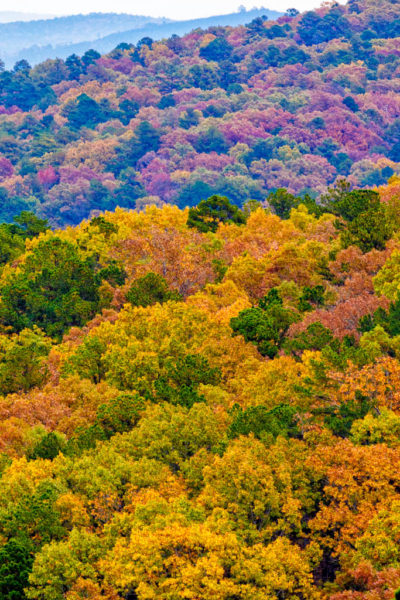Not having been to the Ouachita National Forest in several years, I decided yesterday would be a good time to make the trip and look for some autumn foliage. The Ouachita National Forest covers 1.8 million acres and extends from central Arkansas into southeastern Oklahoma. The drive to the forest is slightly over one hour from my house, and the cloudy sky and lack of wind created the perfect conditions for fall photography. So, I loaded up my equipment and headed out.
Upon arriving, my first stop was Lake Sylvia, where I hoped to photograph colorful leaves and their reflections on the water. Unfortunately, access to the lake was closed, and it appeared the surrounding trees had already dropped a lot of their leaves. This concerned me a little bit because, in Arkansas, the trees seem to be notorious for losing their leaves just before the cooler temperatures cause the colors to start changing.
I continued on as the road narrowed into, essentially, a single lane path through the trees. I slowly looped my way back toward one of the main highways that access the forest. As I topped a small crest, the road widened, and I could see the incredible colors of the trees as they covered a series of distant ridgelines. I immediately stopped my truck and hopped out to find the perfect vantage point from which to shoot.
Holding my camera, I would stand in a spot, look through the viewfinder, and assess the scene. I would then take a few more steps, look through the viewfinder again, and reassess the image. I repeated this process several times until I found the perfect location that gave me the most unobstructed view of the various ridges.
Setting up my tripod in my selected position, I realized I had a problem with no good immediate solution. If I included the overcast sky in the background of the frame, it would appear as extremely light and featureless and would be very distracting in the final image. But, if I angled the camera downward to avoid including the sky, a number of out of focus plants and trees would encroach into the foreground at the bottom of the picture and also be a distraction. I had to make a choice between a distracting background and a distracting foreground.
After pondering this decision for a few seconds, I decided to go with including the sky rather than the out of focus plants and trees. My reasoning was simple – it would be much easier to address the distracting sky later in Photoshop than it would be to deal with the out of focus foreground elements. So, I angled my camera upward until the blurred foreground was out of the frame and tripped the shutter.
Opening the file in Adobe Camera Raw, I significantly increased the overall exposure and contrast of the image, as well as, increasing its vibrance and saturation. I then took the picture into Photoshop where I applied the Tonal Contrast filter to further enhance the photograph’s colors and contrast. Finally, I had to deal with the distracting sky. To do this, I selected the entire image using Ctrl-A and then, from the menu, selected Edit-Transform-Scale. This gave me a number of anchor points along the edges of the picture that I could use to “pull” the image. Selecting the anchor point in the center top of the image, I pulled the picture upward until I eliminated as much of the sky as I could without losing the farthest ridges.
One last point about the extremely small aperture I used for this image. Did I need to use such a small aperture? No. I could have used a larger aperture given the distance from me to the closest point of the scene. However, if any part of the photograph had not been completely sharp, it would have been destined for the recycle bin as soon as I saw it. Since the wind wasn’t blowing, I knew I could get away with a long shutter speed, so I used the smallest aperture I had to ensure adequate sharpness throughout the entire image. Had there been even the slightest breeze, I would have had to reconsider my settings and used a larger aperture with a faster shutter speed.
Settings: 560mm, 1/8 sec, f/57, 400 ISO

Pingback: 2018 Year in Review | Bob Henry Photography